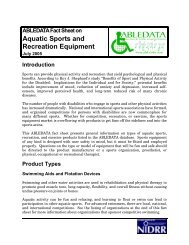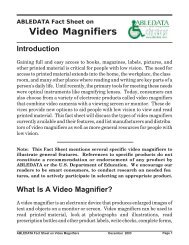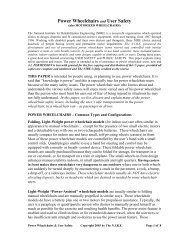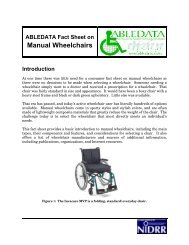Power Wheelchairs and Residential Fire Safety - AbleData
Power Wheelchairs and Residential Fire Safety - AbleData
Power Wheelchairs and Residential Fire Safety - AbleData
You also want an ePaper? Increase the reach of your titles
YUMPU automatically turns print PDFs into web optimized ePapers that Google loves.
use it because of the stress conditions, haste, <strong>and</strong> the presence of so many other people. If<br />
it is to be used to descend stairs, then it should be used for one flight of stairs – or less.<br />
Never for more. Even then, it should be used only by an experienced user; only with<br />
other people kept away for their own safety (should it fall); <strong>and</strong> only after the steps are<br />
visually inspected <strong>and</strong> found to be free of debris. Of course, if visibility (of the steps) is<br />
poor due to power failure, smoke or other factors, use of a stair-climbing/descending<br />
wheelchair should not even be considered.<br />
SOME USEFUL ADDITIONAL INFORMATION – for wheelchair user<br />
evacuations - with or without powered mobility-device removals:<br />
A BASIC DANGER OF STAIR-CLIMBING or DESCENT in a wheelchair is the fact that,<br />
if an occupied stair-climbing wheelchair falls down a flight of stairs (it could fall from near<br />
the top of a 32-step stairway) then serious injury or death to the user is the likely. Others in<br />
the area may also be injured or killed by such a fall.<br />
Age & Health Factors can be very significant to safety, both in preventing – <strong>and</strong> in<br />
surviving accidents. Examples: (1) A young paraplegic with normal upper body<br />
functions <strong>and</strong> strength. This fast moving person, with good eyesight, may well maneuver<br />
fast <strong>and</strong> vigorously enough to prevent an accident. Even if his wheelchair turns over or<br />
falls down a flight of stairs, the person has the highest chance of surviving with minimal<br />
injuries. Or, (2) an elderly paraplegic, or a wheelchair user of any age with upper body<br />
weakness <strong>and</strong> impaired movement abilities, is less likely to prevent an accident or fall at<br />
the last moment <strong>and</strong> is much more likely to suffer serious injuries or death in a fall,<br />
collision or accident.<br />
USERS of <strong>Power</strong> <strong>Wheelchairs</strong> – DISABILITY CATEGORIES & SAFETY RISKS<br />
as summarized below, do not include the added hazards of navigating a power wheelchair<br />
with poor vision or with susceptibility to fainting or unexpected seizures. It is assumed<br />
that all wheelchair users are strapped in for safety. Two straps should be used: one, down,<br />
lap to chair – <strong>and</strong> the other higher up, securing the upper body to the backrest of the<br />
wheelchair. The wheelchair user must be secured both ways for maximum safety.<br />
A) Paraplegics - Healthy, Fit & Active are typically the safest users of manual,<br />
power-assisted, <strong>and</strong> fully powered wheelchairs. LOWEST RISK<br />
B) Amputees – Missing Legs <strong>and</strong>/or Arms but with active upper bodies are usually<br />
safe users of power wheelchairs, depending on the type of control devices used.<br />
If planned <strong>and</strong> implemented properly, then LOW RISK.<br />
C) People with Weak or Poorly Controlled Upper Bodies using st<strong>and</strong>ard joystick<br />
to reliably control power wheelchairs. This category may include some people<br />
with Cerebral Palsy, some with Multiple Sclerosis, some with Parkinson Disease,<br />
<strong>and</strong> people with many other conditions. Some of these conditions may cause<br />
impaired eyesight, slowed reflexes <strong>and</strong>/or impaired judgment. All should be fully<br />
screened for such functional deficits just as for automobile driving safety.<br />
MODERATE RISK.<br />
<strong>Power</strong> <strong>Wheelchairs</strong> & <strong>Fire</strong>-<strong>Safety</strong> Copyright 2004 by The N.I.R.E. Page 4 of 7







